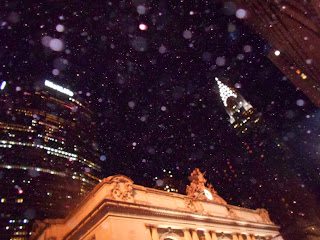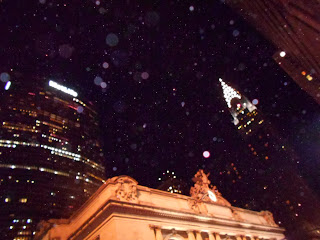Photo date: August 3, 2015. Photographer: Mark Mahin.
In this post I will analyze a series of orb photos taken from a particular angle on one night. I will be looking for evidence of what I call "vertical bias," meaning a tendency for orbs to appear more commonly in the upper part of photographs. If I can find evidence of vertical bias, it will be a strong blow against all theories that orbs are natural particles drifting very near the camera (for under all such theories, orbs should be randomly distributed across the photo area, without any evidence for vertical bias persisting over a series of photos taken from the same angle on one day).
None of the orb photos I will show have been cropped, and all were uploaded directly from the camera.
Here is the first photo in my series, taken at 9:48. (All of the orb photos will show the Met Life building, the Chrysler Building, and Grand Central Station in New York City.)
Here we have about 100 orbs not in front of the lower building, and only about 1 orb in front of the building.
Here is the next photo in my series, taken at 9:48.
Here we have about 60 orbs not in front of the lower building, and no orbs in front of the building.
Here is the next photo in my series, taken at 9:49.
Here we have about 30 orbs not in front of the lower building, and none in front of that building.
Here is the next photo in my series, taken at 9:49.
Here we have about 30 orbs not in front of the lower building, and none in front of that building.
Here is the next photo in my series, taken at 10:02.
Here we have about 100 orbs not in front of the lower building, and perhaps 1 in front of that building.
Here is the next photo in my series, taken at 10:02.
Here we have about 100 orbs not in front of the lower building, and none in front of that building.
Here is the next photo in my series, taken at 10:03.
Here we have about 80 orbs not in front of the lower building, and none in front of that building.
Here is the next photo in my series, taken at 10:03.
Here we have about 100 orbs not in front of the lower building, and about 1 in front of that building.
Here is the next photo in my series, taken at 10:03.
Here we have about 100 orbs not in front of the lower building, and about 2 in front of that building.
Here is the next photo in my series, taken at 10:03.
Here we have about 50 orbs not in front of the lower building, and none in front of that building.
Here is the next photo in my series, taken at 10:05.
Here we have about 20 orbs not in front of the lower building, and none in front of that building.
Here is the next photo in my series, taken at 10:05.
Here we have about 20 orbs not in front of the lower building, and about 1 in front of that building.
Here is the next photo in my series, taken at 10:05.
Here we have about 30 orbs not in front of the lower building, and none in front of that building.
Here is the last photo in my series, taken at 10:05.
Here we have about 25 orbs not in front of the lower building, and 1 in front of that building.
The totals are these: there were about 845 orbs that were not in front of the lower building, and only about 7 orbs that were in front of that building.
On average, the lower building occupied about one seventh of the total photo area. What is the probability of getting such results from a random distribution of particles? This is the same as you getting only 7 successes in a series of 845 trials in which the chance of success per trial is 1 in 7.
The chance of such a thing happening can be calculated using the handy "binomial probability calculator" located here at StatTrek.com. Typing in the numbers below in their calculator, we get the following result:
The 6.03E-46 is exponential notation meaning 6.03 X 10-46 which is about 1 chance in 10,000,000,000,000,000,000,000,000,000,000,000,000,000,000,000. So there is basically zero chance of getting only 7 successes in a series of 845 trials in which the chance of success per trial is 1 in 7.
In short, this photo series provides very strong evidence of a vertical bias in the distribution of the orbs I was photographing, showing that the orbs were not at all randomly distributed around the photo area, but were distributed far, far more frequently in the upper area of the photos. Such evidence rules out any possibility that such orbs were caused by particles very close to the camera lens (whether dust, pollen, water vapor, or rain drops), because any such particles drifting very near the camera would have to be randomly distributed around the photo area.
We also cannot regard these orbs as being specks on the camera lens, as the orbs appear differently in every photo. We cannot explain these orbs as being dust far from the camera, as dust particles far from the camera would appear in a photo smaller than tiny fleas photographed at a distance of 20 meters. Nor can we explain these orbs as being some camera malfunction, because in the middle of taking the photos above, I took the two photos below (the first at 9:48 and the second at 9:53), of a piece of cardboard at arm's length -- and neither of these photos showed any orbs.
Here is the photo taken at 9:48:
.Here is the photo taken at 9:53:
In short, this series of photos provides powerful evidence against the main attempts to naturally explain orbs, and leaves an objective observer with the idea that we are seeing here some paranormal mystery that is completely unexplained.
There was no fog, mist, rain, or precipitation on this night. The air quality listed on airnow.gov was "good," with a rating of
41.

















No comments:
Post a Comment